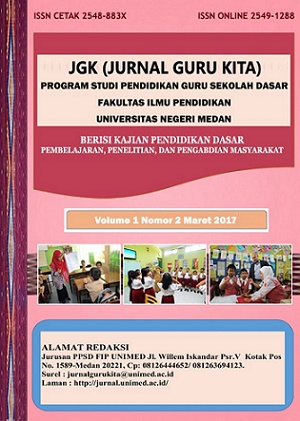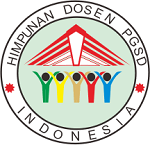Penerapan Metode Ceramah Variasi Dan Diskusi Serta Media Gambar Untuk Meningkatkan Kemampuan Siswa Pada Mata Pelajaran PKn Kelas V Di SDN 3 Grobogan.
DOI:
https://doi.org/10.24114/jgk.v1i2.6276Abstract
Abstrak : Penerapan Metode Ceramah Variasi Dan Diskusi Serta Media Gambar Untuk Meningkatkan Kemampuan Siswa Pada Mata Pelajaran PKn Kelas V Di SDN 3 Grobogan. Tujuan dari penelitian tindakan kelas ini adalah untuk mengetahui penerapan metode ceramah variasi dan diskusi serta penggunaan media gambar dalam meningkatkan kemampuan siswa pada mata pelajaran PKn Standar Kompetensi Memahami Kebebasan Berorganisasi Kelas V. Subyek dalam penelitian ini adalah siswa kelas V SD Negeri 3 Ngambakrejo. Dilaksanakan pada semester genap tahun pelajaran 2015/2016. Hasil penelitian menunjukkan ketuntasan belajar meningkat yaitu siklus I siswa tuntas sebanyak 13 siswa dengan nilai rata-rata 73,10. Siklus II siswa yang tuntas sebanyak 15 siswa dengan nilai rata-rata kelas 78,94. Kata Kunci : Hasil Belajar PKn, Metode Ceramah Variasi, DiskusiDownloads
How to Cite
Karmini, K. (2017). Penerapan Metode Ceramah Variasi Dan Diskusi Serta Media Gambar Untuk Meningkatkan Kemampuan Siswa Pada Mata Pelajaran PKn Kelas V Di SDN 3 Grobogan. JGK (Jurnal Guru Kita), 1(2), 1–9. https://doi.org/10.24114/jgk.v1i2.6276
Issue
Section
Articles
License
Authors published with the JGK (Jurnal Guru Kita) agree to the following terms:
- Authors retain copyright and grant the journal the right of first publication with the work simultaneously licensed under a Creative Commons Attribution License (CC BY-SA 4.0) that allows others to share the work with an acknowledgment of the work's authorship and initial publication in this journal.
- Authors are able to enter into separate, additional contractual arrangements for the non-exclusive distribution of the journal's published version of the work (e.g., post it to an institutional repository or publish it in a book), with an acknowledgment of its initial publication in this journal.
- Authors are permitted and encouraged to post their work online (e.g., in institutional repositories or on their website) prior to and during the submission process, as it can lead to productive exchanges, as well as earlier and greater citation of published work. (See The Effect of Open Access)


























